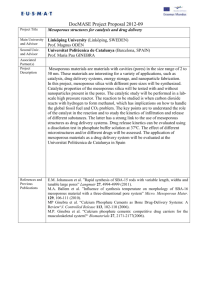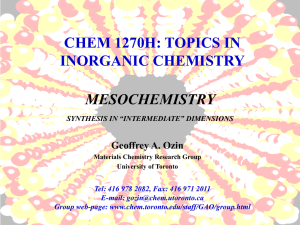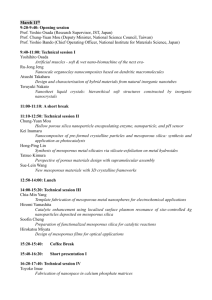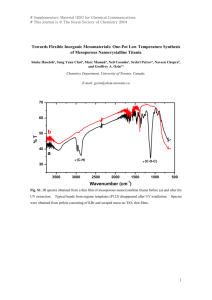Synthesis of Mesoporous Materials
advertisement
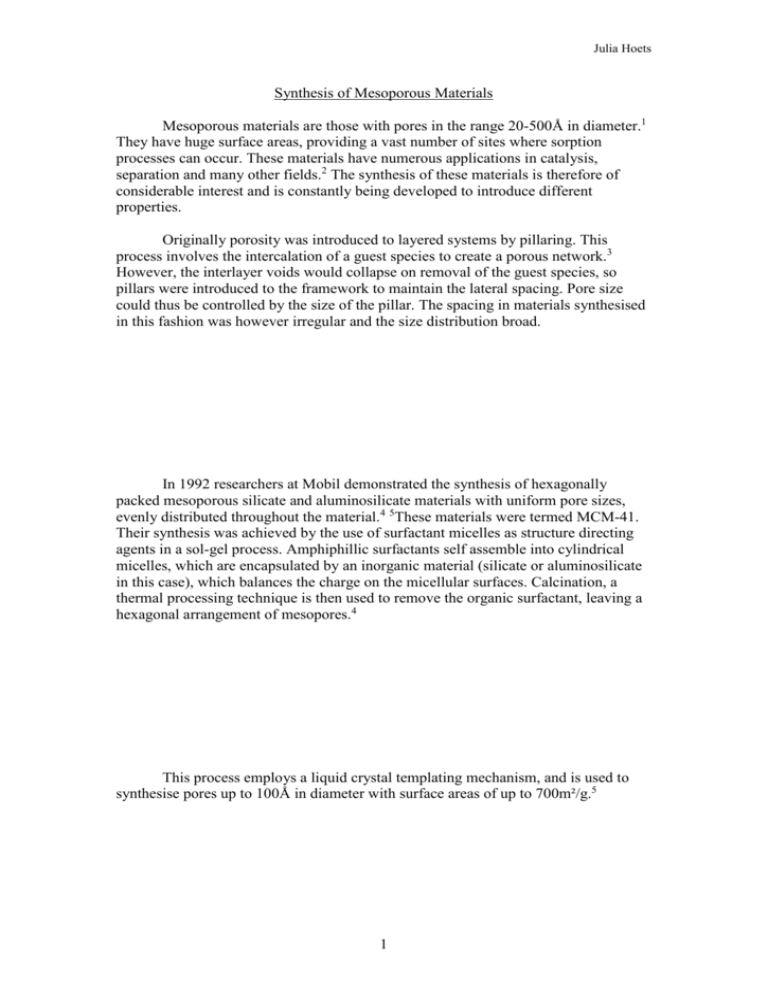
Julia Hoets Synthesis of Mesoporous Materials Mesoporous materials are those with pores in the range 20-500Å in diameter.1 They have huge surface areas, providing a vast number of sites where sorption processes can occur. These materials have numerous applications in catalysis, separation and many other fields.2 The synthesis of these materials is therefore of considerable interest and is constantly being developed to introduce different properties. Originally porosity was introduced to layered systems by pillaring. This process involves the intercalation of a guest species to create a porous network.3 However, the interlayer voids would collapse on removal of the guest species, so pillars were introduced to the framework to maintain the lateral spacing. Pore size could thus be controlled by the size of the pillar. The spacing in materials synthesised in this fashion was however irregular and the size distribution broad. In 1992 researchers at Mobil demonstrated the synthesis of hexagonally packed mesoporous silicate and aluminosilicate materials with uniform pore sizes, evenly distributed throughout the material.4 5These materials were termed MCM-41. Their synthesis was achieved by the use of surfactant micelles as structure directing agents in a sol-gel process. Amphiphillic surfactants self assemble into cylindrical micelles, which are encapsulated by an inorganic material (silicate or aluminosilicate in this case), which balances the charge on the micellular surfaces. Calcination, a thermal processing technique is then used to remove the organic surfactant, leaving a hexagonal arrangement of mesopores.4 This process employs a liquid crystal templating mechanism, and is used to synthesise pores up to 100Å in diameter with surface areas of up to 700m²/g.5 1 Julia Hoets Sol-gel technology, first used in 1846 by J.Ebelman6, is now commonly used in the synthesis of ceramics. It involves the formation of a solid phase, through the gelation of a colloidal suspension (sol)6. There are two possible routes for this process7: i)Inorganic route ; this hydrothermal technique involves the formation of a sol from a very fine powder of the silicate starting material. This is then heated and dehydrolysed to form the ceramic via a gel state. ii)Organic route ; here the starting material has an organic component, for example TEOS (tetraethylorthosilicate) which is hydrolysed to form a gel, thus losing ethanol, and then heated to form the ceramic. This is a more expensive route but forms pure products of optical and electronic quality2. The liquid crystal templating mechanism used by Mobil in 19924 5 involved the dissolution of a surfactant species in the pre-hydrolysed inorganic pre-cursor8. The mechanism is strongly influences by electrostaic and steric interactions between the solvent molecules, the inorganic species and the self assembled organic surfactants9. A wide variety of surfactants, with different properties; anionic, lipid, zwitterionic even two-tailed species, are used to introduce the mesopores10. Ionic surfactants self assemble into micelles, governed by the matching of charge densities at surfactant – inorganic interfaces11. Neutral templating, involving non-charged species (often primary amines) is based upon hydrogen bonding. Larger pores, up to 140Å, can be synthesised by using amphiphilic block copolymers12 with a wide variety of characteristics13. Materials formed by this method are hydrothermally stable due to their excellent interfacial stabalisation properties14. They also have long ordering lengths, thick walls and large pores15. Surfactants can even be covalently bonded to the inorganic precursor as a ligand16. The removal of the surfactant also has many options. The traditional method is calcinations. The inorganic – surfactant complex is heated to high temperatures for extended periods under a flow of air, oxygen or nitrogen, to “burn off” the surfactant molecules12. Forceful conditions are required to break the strong electrostatic bonds between the micelles and the inorganic species. The non-ionic templating approach allows the removal of the surfactant by solvent extraction, as the hydrogen bonding involves is more easily broken. The surfactant is recovered and therefore can be recycled17. Other methods include plasma and super-critical fluid extraction17. A recent journal (feb 2001) published a paper detailing surfactant removal by 18 ozone . This involves a highly exothermic process, which cannot currently be controlled. Treatment with ozone forms larger pores, with a decreased size distribution and increased order. Pore size can be controlled by the choice of surfactant. The diameter can be increased by lengthening the alkyl chain, addition of an auxiliary hydrocarbon such as an alkylated benzene, or solution of an organic species in the hydrophobic micellular regions4. 2 Julia Hoets Aqueous emulsions of amines can be used as swelling agents, inducing up to a 3-fold enlargement of pores, at the cost of a decrease in ordering19. Manipulation of temperature and acidity can also affect the size and even the shape of the pores20 creating gyroid rather than spherical mesopores. Branched, 3D networks of pores can be synthesised by polymerisation of the silicate anions around micelles with organic salts at high temperatures21 this allows the porous system to become more resistant to blocking, leading to faster diffusion through the system. Mesopores can be further modified by the functionalisation of the pore surface . This can alter surface properties such as acidity, hydrophobicity, or specific affinity. The functional group is added to the inorganic precursor by copolycondensation where it will replace an alkoxy group. 2 Transition metal oxide structural equivalents of mesoporous materials are highly sought after, due to the combination of a high surface area and strong catalytic properties. They also have useful applications in electrochemistry22. The first synthesised was a TiO2 based hexagonally packed material, synthesised by a similar process as the silicate but under acidic conditions23. Mesoporous materials of Sb and Pb oxides have since been synthesised using polyglycols as surfactants9. Thin films of mesoporous materials, classed KIT-1, have recently been synthesised and may find a range of applications in membrane based separations, selective catalysis and biomedicine24. They were originally grown on freshly cleaved mica substrates under acidic conditions25 but were later discovered to form at airwater interfaces under the same condtions26 It can therefore be seen that by making variations on one simple synthetic process, a wide range of mesoporous materials with many different properties and numerous applications can be made. (Italics show the source used to find the reference.) 1 www. mesoporous. com, International Mesostructured Material Association. (From Yahoo search engine.) 2 Davies, S., Goltner, C., Mesoporous Silica from Supramolecular Templating, University of Bristol, Inorganic Practical – level II, experiment 8. (From relevant practical handout.) 3 Schöllhorn, R., Intercalation Systems as Nanostructured Functional Materials, Chem.Mater.,1996, 8, 1747-1757. (From list of references in reference number 13.) 4 Kresge, C.T. et al. Ordered Mesoporous Molecular Sieves Synthesised by a Liquid Crystal Template Mechanism, Nature, 1992, 359, 710-712. (Starting reference – given.) 5 Beck, J.S. et al. A New Family of Mesoporous Molecular Sieves Prepared with Liquid Crystal Templates, J.Am.Chem.Soc., 1992, 114, 10834-10843. (Starting reference – given.) 6 Lev, O., Sol-gel Materials in Electrochemistry, Chem.Mater., 1997, 9, 2354-3375. (From list of references in reference 15.) 3 Julia Hoets 7 Pringle, P.G., University of Bristol Level II lecture notes. (From relevant lecture material.) 8 Ogawa, M., Simple Sol-gel Route for Preparation of Silica-Surfactant Mesoporous Materials, Chem.Commun., 1996, 1149-1150. (From computer citation search using Mesoporous Materials as a subject.) 9 Vaudry, F., et al. Synthesis of Pure Alumina Mesoporous Materials, Chem.Mater., 1996, 8, 1451-1464. (From list of references in reference 15.) 10 Huo, Q., Organisation of Organic Molecules with Inorganic Molecular Species into Nanocomposite Biphase Arrays, Chem.Mater., 1994, 6, 1176 – 1184. (From list of references in reference 14.) 11 Monnier, A. et al. Cooperative Formation of Inorganic-Organic Interfaces in the Synthesis of Silicate Mesostructures. Science, 1993, 261, 1299 - 1303. (From list of references in reference 14.) 12 Yang, P., et al. Generalised Synthesis of Large Pore Mesoporous Metal Oxides with SemiCrystalline Frameworks, Nature, 1998, 396, 152 - 155. (From computer citation search using Yang, P. as an author.) 13 Yang, P., et al. Triblock Copolymer Directed Synthesis of Large Pore Mesoporous Silica Fibres. Chem.Mater. 1998, 10, 2033 – 2036. (From list of references in reference 15.) 14 Zhao, D., et al. Non-ionic Triblock and Star Diblock Copolymer and Oligomeric Surfactant Synthesis of Highly Ordered, Hydrothermically Stable, Mesoporous Silica Structures, J.Am.Chem.Soc., 1999, 12, 6024 – 6036. (From computer citation search using mesoporous as a subject.) 15 Yang, P., et al. Block Copolymer Templating Synthesis of Mesoporous Metal Oxides with Large Ordering Lengths and Semicrystalline Frameworks, Chem.Mater. 1999, 11, 2813 – 2826. (From computer citation search using Yang, P. as an author.) 16 Yang, P., Synthesis and Characterisation of Hexagonally Packed Mesoporous Tantalum Oxide Molecular Sieves. Chem.Mater. 1996, 8, 874 – 881. (From computer citation search using Yang, P. as an author.) 17 Tanev, P.T., et al. A Neutral Templating Route to Mesoporous Molecular Sieves, Science, 267, 865 – 867. (From list of references in reference 15.) p 18 Büchel, G., In situ Surfactant Removal of MCM-type Mesostructures by Ozone Treatment, J.Mater.Chem. 2001, 11 (2), 589 – 595. (From reading new editions of the journal of materials chemistry.) 19 Sayari, A., Yang, Y., Expanding the Pore Size of MCM-41 Silicas : Use of Amines as Expanders in Direct Synthesis and Postsynthesis Procedures. J.Phys.Chem. B, 1999, 103 (18), 3651 – 3658. (From computer citation search using MCM-41 as a subject.) 20 Yang, H., et al. Synthesis of Mesoporous Silica Spheres under Quiescent Aqueous Acidic Conditions. J.Mater.Chem., 1998, 8 (3), 743 – 750. (From list of references in reference 18.) 21 Ryoo, R., Disordered Molecular Sieve with Branched Mesoporous Channel Network, J.Phys.Chem., 1996, 100, 17718 – 17721. (From computer citation search using mesoporous as a subject.) 22 Huo, Q., et al. Generalised Synthesis of Periodic Surfactant / Inorganic Composite Materials, Nature, 1994, 368, 317 - 321. (From list of references in reference 6.) 23 Antonelli, D., et al. Synthesis of Hexagonally Packed Mesoporous TiO 2 by a Modified Sol-gel Method, Agnew.Chem.Int.Ed.Eng., 1995, 34, 2014 – 2017. 4 Julia Hoets (From computer citation search using mesoporous as a subject.) 24 Lu, Y., et al. Continuous Formation of Supported Cubic and Hexagonal Mesoporous Films by Sol-gel Dip Coating. Nature, 1997, 389, 364 - 368. (From list of references in reference 19.) 25 Yang, H, Synthesis of Oriented Films of Mesoporous Silica of Mica, Nature, 1996, 379, 703 - 705. (From list of references in reference 26.) 26 Yang, H., Free-Standing and Oriented Mesoporous Silica Films Grown at the Air Water Interface, Nature, 1996, 381, 589 – 592. (From computer citation search using mesoporous as a subject.) 5
